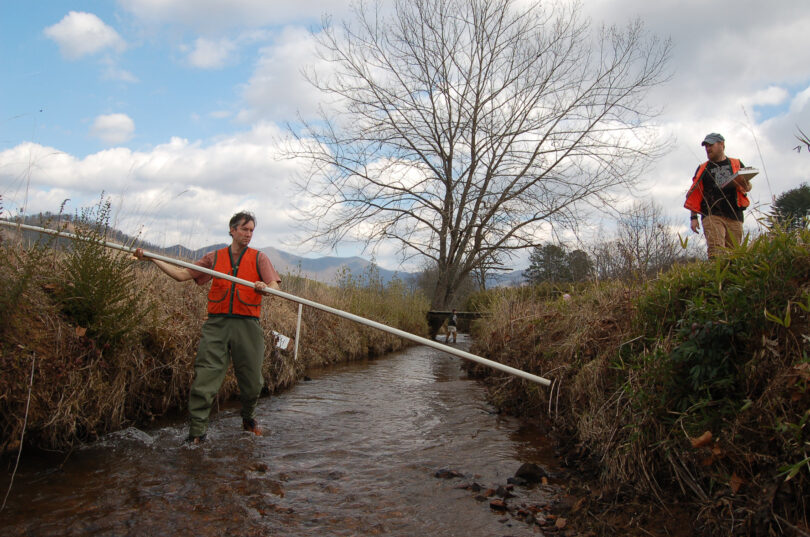
UGA professor Rhett Jackson (left) takes a sample from a creek in Macon County, North Carolina. (Photo by Rhett Jackson)
by Kristen Morales
Unpaved roads, open pastures and land use
patterns contribute to poor water quality
Mountain spring water is often touted as the cleanest water you
can drink. But a new study from the University of Georgia revealed
this isn’t the case.
Using data
collected over 40 years, researchers detailed how water quality in
high-elevation streams has been negatively affected by a combination of
historical events and modern changes, namely sediment from rural roads and
agricultural runoff.
Unpaved roads are
just one of several factors contributing to sediment runoff, said Rhett
Jackson, a professor at UGA’s Warnell School of Forestry and Natural Resources
and the paper’s lead author.
The paper was published earlier this
fall in the journal Bioscience.
“We had access to
studies from 1976 to last year that encompassed both stream and terrestrial
studies,” said Jackson, who worked with researchers from Virginia Tech, the
University of Illinois, the University of Minnesota and the U.S. Forest Service
to analyze streams in a mountainous portion of North Carolina adjacent to the
Coweeta Long-Term Ecological Research Site.
When streams carry
a lot of sediment, it makes it more difficult for animals to see food in the
water, and it affects fish growth and disease resistance. Sediment also
continues to flow downstream and into public water supplies, where it costs
cities and towns more to filter.
“Some streams in
Macon County have very high sediment concentrations, four times greater than
found in forested streams,” added Jackson.
The cost of a view
It’s important to
note that Appalachian water quality issues began more than 100 years ago, said
Jackson, when European settlers fundamentally changed the balance of the land
long inhabited by Native Americans.
“The landscape you
see now isn’t what it was like in 1900—the early settlers logged everything,”
said Jackson. For generations, native Cherokee Indians farmed the valleys of
the Southern Appalachians and left the hillsides forested, for hunting and gathering.
But the new settlers cut the forests and even tried to farm the hills, causing
erosion and sediment to move into the streams. Today, stream beds continue to
show evidence of sediment deposited more than a century ago, even as new
sediment pushes through the waters.
Many years later, a
new kind of development in the region created a different kind of land
disturbance. For generations, residents considered the steep mountain slopes
undevelopable. But the 1980s and ’90s brought a desire for mountain getaway
homes with views.
By building homes
on mountain ridges, he said, it created more land disturbance through carving
out unpaved roads and cutting into hillsides, sometimes creating landslides.
“Roadside ditches
and unpaved roads produce a lot of sediment, and their sediment production
increases as roads get steeper and as gravel roads get more use,” said Jackson.
A typical southern
Appalachian forest stream contains sediment amounts—calculated as total
suspended solid concentration—of about 8 to 10 milligrams per liter. But in
areas with both mountain and valley development, the researchers found sediment
concentrations four to six times higher.
Agricultural issues
Farming also takes
its toll. The studies researchers analyzed found many streams in the area to
have high nutrient concentrations—particularly nitrate. When a stream flowing
through a pasture loses its buffer of trees, it loses a natural protection
against nutrient runoff.
Streams without
shade also have higher water temperatures. In Appalachia, where mountain trout
and other wildlife thrive in cold waters, even a few extra degrees in the
summer can kill trout or reduce their competitiveness against warm water fish.
Jackson said about
40% of streams in the study area aren’t buffered. But through best-management
practices and state and federal programs, landowners can find assistance and
resources to reverse the damage. “On small streams, the actions of individual
landowners matter a lot,” he said. “Sometimes, we see unusual streamside
activities with substantial water quality effects.” For example, researchers
found instances of streams diverted through animal enclosures or illicit
discharge pipes without clear sources.
Even small steps,
such as buffering runoff from a gravel road or planting trees near an open
stream, can go a long way, Jackson said.
“Because the water in streams comes
from the whole landscape, everything we see on the land has some effect on
streams,” he said. “But streams are resilient, and as long as we intelligently
modify our actions a little bit, we can farm and live near streams while
protecting their water quality. Maintaining the quality of our landscape
requires a little thought and work on our parts.”
(Source: UGA Today, https://news.uga.edu/mountain-spring-water-isnt-as-clean-as-you-think-it-is/)

